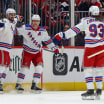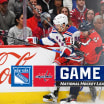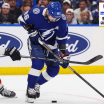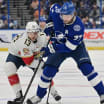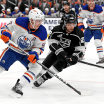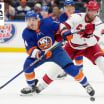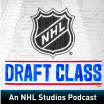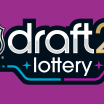Goaltending plays an integral part in the Stanley Cup Playoffs, so NHL.com is breaking down the battle between the pipes in each postseason series, charting goals to find strengths, weaknesses and targetable tendencies.
Corey Crawford, a two-time Stanley Cup winner with the Chicago Blackhawks, is coming off a regular season worthy of a Vezina Trophy nomination despite missing close to a month down the stretch. Brian Elliott of the St. Louis Blues had an NHL-leading .930 save percentage in 38 starts this season, but still is looking to prove himself in the playoffs after being passed over by the Blues in each of the past two postseasons. There is nothing in Elliott's game, which has continued to evolve since his last opportunity, to suggest he can't get it done in the playoffs. But, until he does, critics will point to his .897 save percentage in 19 career postseason appearances.
Teammates can rely on Crawford, Elliott
Blackhawks-Blues goalie matchup too close to call
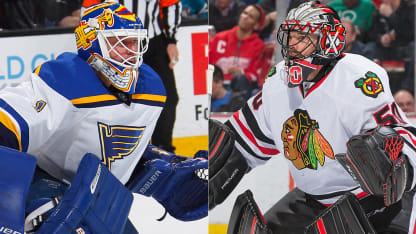
POSITIONING:Crawford plays a contained, controlled style mostly between three-quarters and the top edge of his crease, improving his lateral rotations and movement to establish a balance between the strong technical foundation that defined him coming into the NHL and the more aggressive, reactionary athleticism he tried too hard at times to show off during his second full season as a starter.
Elliott plays a deeper style, getting his heels out to the top edge of his crease against the rush, but mostly playing farther back in his crease toward the goal line, prioritizing early angle over depth with short, quick movements that keep him in the middle of the net and square the shooter.
Advantage: Because he is slightly less exposed high than his deeper counterpart, Crawford.
BLOCK/REACT THRESHOLD: When he's playing well, Crawford reacts from his skates, moving into shots in straight lines with his feet and hands. When he starts to struggle, there is a tendency to react more from his knees, defaulting down and pulling his hands in tight before reacting back out and up with his hands once he hits the ice, a costly delay that shows up more on plays closer to the net.
Elliott only defaults to a blocking butterfly on bang-bang plays in tight with little time to react, relying instead on some of the most active, engaged hands west of Henrik Lundqvist to make up for any coverage lost by playing a deeper style that also is somewhat reminiscent of the New York Rangers star. Elliott uses an active stick to cut off passing lanes through his crease, and won't hesitate to throw out a poke check.
Advantage: Because his positioning wouldn't work without those incredible hands, Elliott.
PUCKHANDLING:Crawford won't make anyone think of Marty Turco with pretty breakouts, but he gets out to set up pucks behind his net and makes short passes a bit more than Elliott. Blues coach Ken Hitchcock said his defense plays differently when Jake Allen is in goal because of his ability to handle the puck and start the transition, whereas Elliott freezes more plays to set up faceoffs in his own end.
Advantage: Because it's not hard to have at least a little edge here, Crawford.
POST PLAY: Crawford got caught on his skates on plays below the goal line two seasons ago, which left him caught in transition and beat by low shots several times last season and in the playoffs. Last season, he added the reverse-VH technique, dropping the short-side skate and pad on the ice and sealing the post by leaning the upper body into it. But he still struggled with his execution, including three goals allowed in one playoff series against the Minnesota Wild, who appeared to be targeting his delays coming off the post because he had to lean so heavily into it. Crawford seems to have found a better balance between holding his skates this season, including the use of an overlap technique on low rush chances, and a more effective reverse-VH execution this season, limiting this exposure.
Elliott also has a nice balance between staying up on his skates and using the reverse-VH as a save selection rather than deferring to it anytime a puck is near or below the goal line. He is more active with his stick on plays in tight, cutting off passes coming through the crease, and, while his skate-on-post execution of reverse-VH can leave a short-side gap, his active hands usually help close it.
Advantage: Because each goalie does a nice job of not deferring too early to one option, even.
SCORING TRENDS: Crawford has improved this season, particularly when he is tracking well and beating passes to position. But there still is a tendency to pull off shots, especially when he doesn't get fully set and square after lateral movement on the skates, opening up his hip on mid-to-high glove shots and limiting his extension on low blocker shots rather then moving into them.
Elliott gets better rotation into angle when he moves to his glove side compared to his blocker, but in each case is better at tracking down plays and closing on shots while maintaining active hands, especially his glove. His depth and size leave him more vulnerable to one-timers high off lateral plays that cross the slot, and he can get caught outside his posts as rushes get low and wide. This leaves him more exposed to rebounds off the far-side pad and passes into the middle, but the Blues defend each well.
Advantage: Because his exposure is more limited to specific situations, Elliott.
